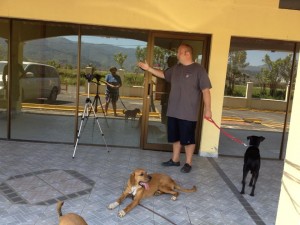Dog Training and Culture
As I’ve previously written on this blog I’m currently living with my family in Costa Rica. We’re working on a variety of projects from work projects to charitable projects along with attempting to learn how to surf and playing in the pool a lot.
One of these projects I’m working on is a new spanish language dog training site where I’m teaching a lot of my dog training concepts in the Spanish language and am creating a Spanish language equivalent to my current dog training DVD product line.
I’m working with a lot of the locals here in both private training at their homes and group training classes in front of a local veterinarian’s office. Aside from the fact that it’s VERY hot here and my video work catches me sweating quite a bit I’m running into some new types of dog training challenges that I haven’t run across before.
No, when it comes to bad dog behavior I’m pretty sure I’ve seen a pretty wide range over the years from everything to puppy problems, aggression, house training, destruction, and more. What I’m seeing here, though, is a difference in dog training culture and that is posing new challenges to my work. I’m learning how to adapt my training style based on how people perceive dogs and I’m doing my best to help push the dog culture in a direction that I think is more beneficial.
Dog Training- What Are The Cultural Challenges?
Let me first state that I love the people here in Costa Rica. They are warm, open, and inviting. I have the luxury of speaking Spanish so I can fit in pretty quick with new groups. My wife and kids don’t speak Spanish yet but, even so, they are finding the people to be so accepting and open.
I say that because as I outline the cultural differences here I don’t want to come off as sounding like I’m ‘spitefully critical’ or that I feel that I am a better person because my dog culture is different. Bear in mind, I do feel like the culture I bring to dogs IS better than what I’ve found here but that doesn’t mean that I am a better person because of that.
Here are the main differences that I chalk up to cultural variances between what I typically see here in Costa Rica and what I’m typically accustomed to in the United States:
- Dog crates- I’ve yet to meet someone who has used a dog crate to house train a dog or work on destruction. In the United States the culture has shifted towards large scale acceptance of dog crates or dog kennels. In fact, in my Salt Lake City dog training company it is more rare to NOT see someone with a crate during a first session than it is to see a dog owner who does have a crate. It’s been pretty well established that crates are a humane way to supervise a dog in order to prevent destruction, chewing, digging, and housebreaking accidents. In contrast, the dog owners in this area seem to have zero aversion when I bring up the crate as a potential tool. It’s not that they are against using a crate, it’s just that it’s not something that has been done in this culture so it’s not really even considered. I think the other part of the equation that has prevented the crate from entering into cultural use is the expense. An average salary in this area is in the range of $350-$800 per month. Import taxes are high meaning a crate is going to cost $200 or so. Imagine spending a large portion of your monthly salary on a crate? Doesn’t seem feasible does it? We know some folks who are spending less than $200 on their rent for their house so imagine trying to find room in the budget to buy a crate. For many it just isn’t doable. In not being doable, though, it becomes very difficult to fix issues related to destruction and housebreaking.
-
Dog fencing- Along those same lines we meet many folks who simply let their dogs go and wander throughout the day. In many parts of rural America you can still find this as an accepted custom but in most parts of the U.S. letting your dog wander the neighborhood is sure to quickly make you a pariah. Most folks would rather be the ones who leave their Halloween decoration up until February rather than be the family that releases it’s dog onto the neighbors. I’ve found it quite acceptable here to simply let your dogs run wild in the neighborhood. Add the fact that very few people spay and neuter and it’s no wonder why there are plenty of stray dogs and aggression problems amongst dogs run rampant. Many of the people with whom I’m working have aggressive dogs and those dogs are let loose all day, get in dog fights, form unhealthy relationships with other dogs, and generally get into trouble.
- Dog leashes- I was talking with a friend the other day and they mentioned how their neighbor walks his dog every day off leash. The dog is aggressive and if it sees another dog it will immediately attack. If it sees a bicycle it will give chase. Does this deter the neighbor from continuing to walk the dog off leash with zero control? Nope. I’ve come to realize that having control over a dog is something that is culturally foreign here. For generations dogs have lived on the street and run wild. The idea that we should teach them control seems very off to many dog owners.
Dog Training Culture- The Solution
So is there a solution to change the dog training culture in a positive way? I think so. And I’m already seeing certain evidences of how the culture is shifting towards something positive:
- TV shows like Cesar Millan’s El Encantador de Perros have become very popular here and around Latin America. I think these shows have changed the conversation in the United States towards getting your dogs trained and I think the same thing is happening here.
- Rescue organizations are becoming bigger and more influential. In our area here we have the McKee Foundation who helps rescue lots of pets and has been pushing the agenda of spaying and neutering for some time.
- Trainers like myself. I’m hoping that my Spanish dog training site can gain traction and help push people towards responsible care and training of their dogs.










2 Responses to “Dog Training and Culture”
Hello Ty!!!
Your presence here in Costa Rica is a welcome surprise!!! I was just listening to your podcast with Chad Makin, which I very much enjoyed, then enrolled in your articles and videos. It was then I saw your article about being here in Costa Rica!!! We are from near Toronto, Canada, and have bought our retirement home here, and have been here nearly 7 years and just love it, but boy can I relate to the cultural differences relating to dogs!!! I have had a special bond with dogs all my life, and the most I ever had in Canada were two at a time, and they all lived to a grand old age. Can you believe that I have adopted or rescued 12 since I have been here and still have 10 - the other two now live with our son in Perez Zeledon (San Isidro). We are located on the Pacific coast not far south of you just past Dominical and Uvita. Every morning feels like Christmas, to wake up to all these wonderful dogs, who get along famously except for 2. I am not a trainer, but I sure am learning on the job from my many on-line friends who have been exceedingly fun to know and very generous with helpful ideas. And I learn daily from watching and interacting with my dogs. I am so happy that you are creating a new awareness of how dogs ought to be thought of, and I, too have been delighted to see that Cesar has had a huge impact on so many people. It would be so interesting if we could meet while you are here, and if you are planning some courses please do let me know!!! It would be a great pleasure, I’m sure!!! Enjoy all the beauty of nature and the kind-hearted people, and of course, surfing!!!! I look forward to hearing from you if you should have the time to write. Take care, Ty, and all the best with your projects!!! Sincerely, Roxanne Maguire & Co.
Thanks! Good to hear from you. Any time you are willing come on up and we can do some training. Or perhaps we’ll pass by your way on the way to Panama for a visa run.